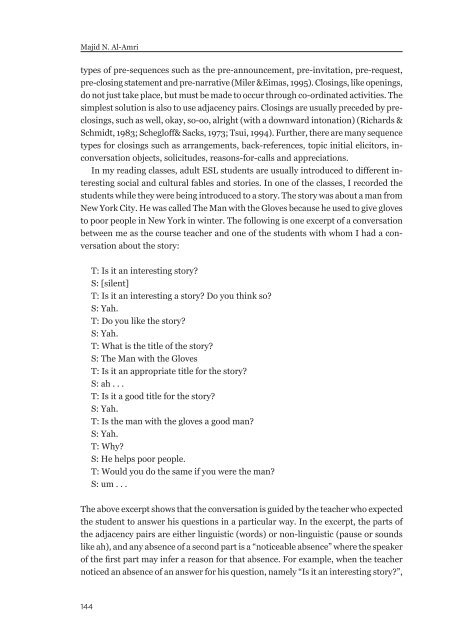Download issue - Umeå universitet
Download issue - Umeå universitet
Download issue - Umeå universitet
You also want an ePaper? Increase the reach of your titles
YUMPU automatically turns print PDFs into web optimized ePapers that Google loves.
Majid N. Al-Amri<br />
types of pre-sequences such as the pre-announcement, pre-invitation, pre-request,<br />
pre-closing statement and pre-narrative (Miler &Eimas, 1995). Closings, like openings,<br />
do not just take place, but must be made to occur through co-ordinated activities. The<br />
simplest solution is also to use adjacency pairs. Closings are usually preceded by preclosings,<br />
such as well, okay, so-oo, alright (with a downward intonation) (Richards &<br />
Schmidt, 1983; Schegloff& Sacks, 1973; Tsui, 1994). Further, there are many sequence<br />
types for closings such as arrangements, back-references, topic initial elicitors, inconversation<br />
objects, solicitudes, reasons-for-calls and appreciations.<br />
In my reading classes, adult ESL students are usually introduced to different interesting<br />
social and cultural fables and stories. In one of the classes, I recorded the<br />
students while they were being introduced to a story. The story was about a man from<br />
New York City. He was called The Man with the Gloves because he used to give gloves<br />
to poor people in New York in winter. The following is one excerpt of a conversation<br />
between me as the course teacher and one of the students with whom I had a conversation<br />
about the story:<br />
T: Is it an interesting story<br />
S: [silent]<br />
T: Is it an interesting a story Do you think so<br />
S: Yah.<br />
T: Do you like the story<br />
S: Yah.<br />
T: What is the title of the story<br />
S: The Man with the Gloves<br />
T: Is it an appropriate title for the story<br />
S: ah . . .<br />
T: Is it a good title for the story<br />
S: Yah.<br />
T: Is the man with the gloves a good man<br />
S: Yah.<br />
T: Why<br />
S: He helps poor people.<br />
T: Would you do the same if you were the man<br />
S: um . . .<br />
The above excerpt shows that the conversation is guided by the teacher who expected<br />
the student to answer his questions in a particular way. In the excerpt, the parts of<br />
the adjacency pairs are either linguistic (words) or non-linguistic (pause or sounds<br />
like ah), and any absence of a second part is a “noticeable absence” where the speaker<br />
of the first part may infer a reason for that absence. For example, when the teacher<br />
noticed an absence of an answer for his question, namely “Is it an interesting story”,<br />
144

















